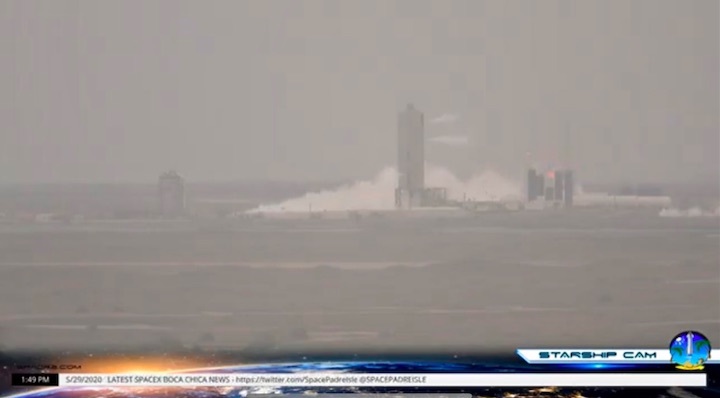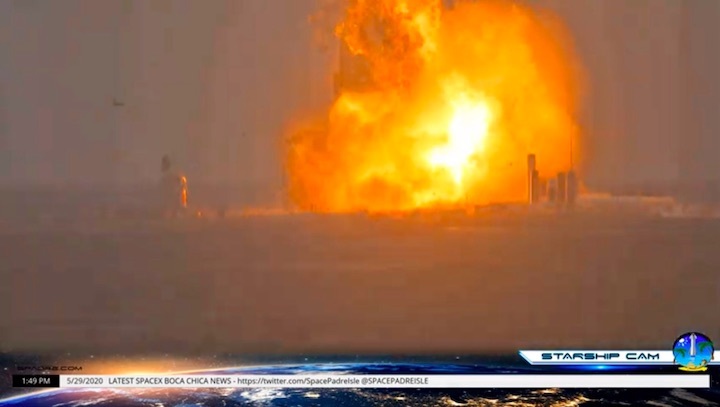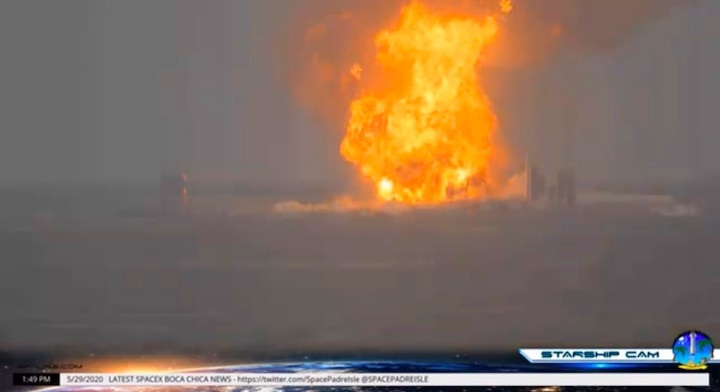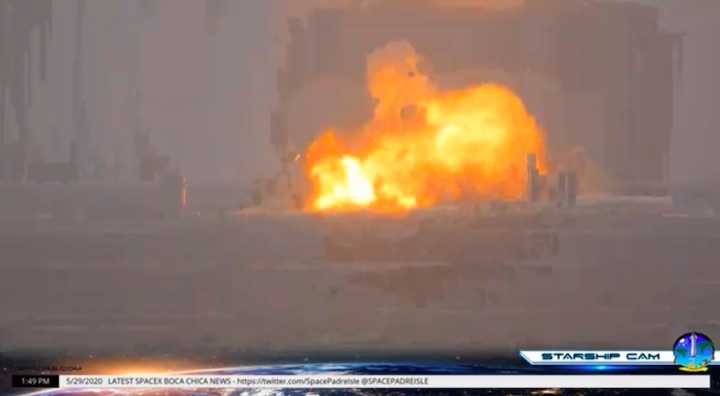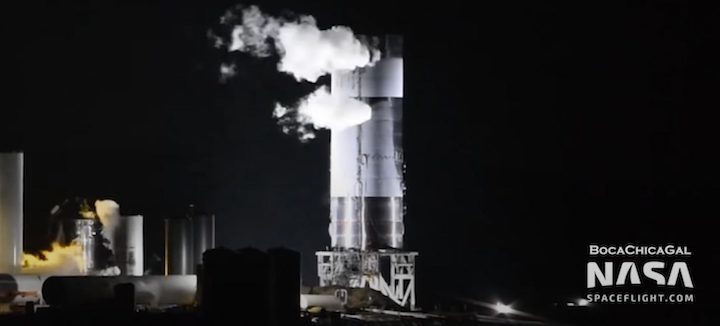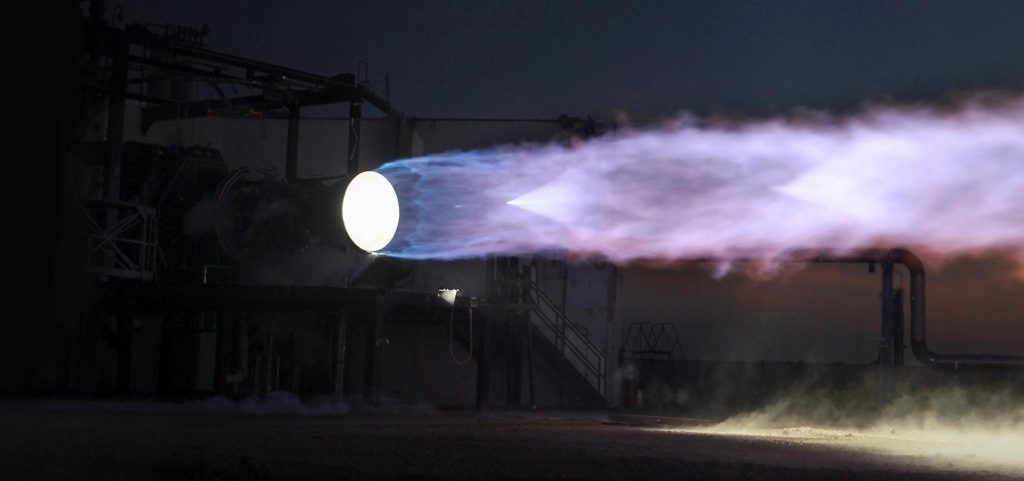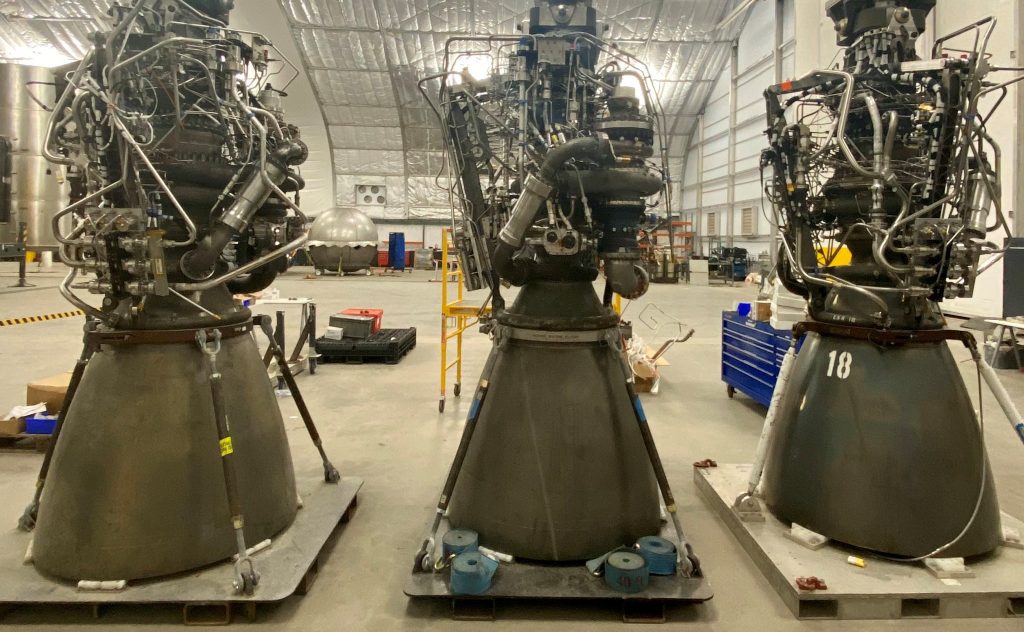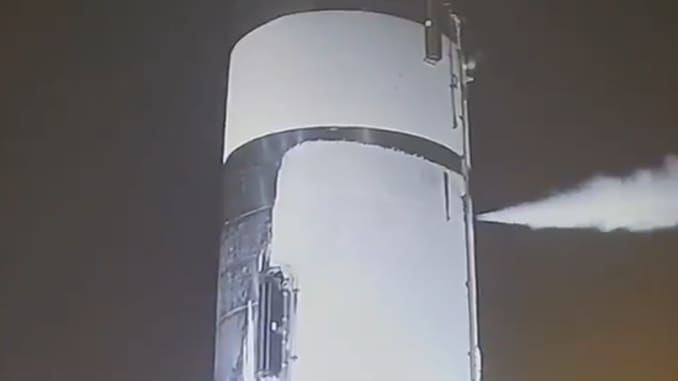
SpaceX successfully conducted a critical test of its Starship prototype on Sunday, in a milestone that foiled previous iterations of the rocket in the past few months.
Elon Musk’s space company performed a pressurized, cryogenic test of its fourth Starship prototype. The test involved filling the rocket’s tank with extremely chilled fuel while under pressure, a process the rocket needs to perform reliably to launch.
The rocket’s tank either burst or collapsed the last three times the company attempted this test since November.
“SN4 passed cryo proof,” Musk said in a tweet.
Starship is a massive rocket that SpaceX is developing, with the goal of launching cargo and people to the moon and Mars. The rocket is designed to be reusable so SpaceX can launch and land it multiple times, like a commercial airplane. Starship’s shiny external appearance is because of the type of stainless steel that SpaceX is using to build the rocket.

Musk said that the company plans to install one Raptor rocket engine for a “static fire” test later this week. If that’s successful, SpaceX will move on to attempting a short flight to about 500 feet altitude. That flight test would be similar to the one SpaceX performed in October with an earlier prototype, nicknamed “Starhopper.”

The company would then install three Raptor engines on the next Starship iteration, Musk said, for even higher flight tests.
SpaceX has been aggressively developing Starship, with the company’s leadership setting the goal of reaching space later this year – and the moon by 2022.
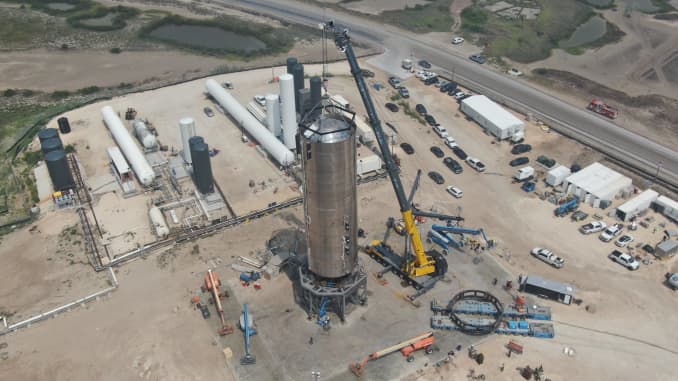
Elon Musk shows off Starship prototype's rocket engine ahead of test fire
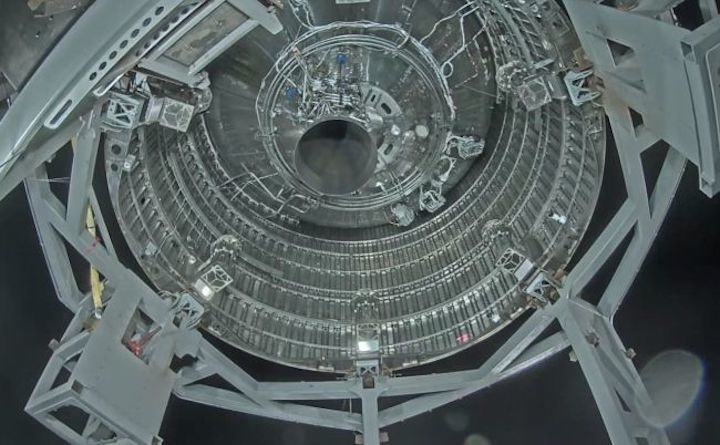
A new photo shows just how big SpaceX's Starship Mars-colonizing vehicle will be.
SpaceX founder and CEO Elon Musk tweeted an image Sunday (May 3) looking up at the belly of the latest Starship prototype, the SN4, which is on the test stand at the company's South Texas site. The shot shows the SN4's single Raptor engine, looking extremely lonely in the center of a 30-foot-wide (9 meters) expanse.
"SN4 fire soon. Raptor looks so smōl," Musk wrote in the tweet.
As Musk noted, the Raptor will get a workout soon, in the form of a "static fire" test, during which the engine will blaze while the rocket is tied down. Indeed, SpaceX aimed to perform the engine test Sunday night but called it off because the Raptor's liquid methane propellant got too warm, Musk explained in another tweet. The next attempt will come soon, likely sometime today (May 4).
If the static fire goes well, SpaceX will start gearing up for an uncrewed test flight with the SN4, taking the prototype about 500 feet (150 m) into the South Texas skies.
Future prototypes will go much higher. For instance, the SN5 will have three Raptors, and SpaceX wants to send that vehicle about 12 miles (20 kilometers) up, Musk has said.
The final Starship will be more powerful still, boasting six engines. The 165-foot-tall (50 m), 100-passenger craft will be capable of blasting itself off the surface of the moon and Mars, Musk has said.
But Starship will need help breaking free of our planet's gravitational grip. So it will launch off Earth atop a giant rocket called Super Heavy, which will be powered by dozens of Raptors. (In earlier designs, Super Heavy could boast 37 engines. But Musk recently tweeted that the rocket will be powered by "only" 31 Raptors.)
Both Super Heavy and Starship will be fully reusable, potentially slashing the cost of spaceflight enough to enable the colonization of Mars, Musk has said. And the Red Planet isn't the pair's only exploration target; the moon is also in play. For example, NASA just awarded SpaceX a contract to develop Starship as a lunar lander, to ferry astronauts to the moon's surface for the agency's Artemis program, which aims to land humans in 2024.
Two other industry groups got similar human-lander contracts: Alabama-based Dynetics and a team headed by Blue Origin, the spaceflight company led by Amazon.com founder Jeff Bezos. Not all of the privately developed landers will necessarily end up flying NASA astronauts; the agency will assess the designs and decide which ones to continue funding. Ultimately, NASA will choose from among the vehicles that make it through to operational flight, purchasing landing missions as transportation services.
Quelle: SC
----
Update: 8.05.2020
.
SpaceX test-fires Raptor engine on Starship test rocket
Video credit: SPadre / YouTube
A test-firing of a Raptor engine on the latest in a series of Starship test rockets Tuesday night in Texas moved SpaceX closer to performing a low-altitude “hop” to gather data on the vehicle’s launch and landing characteristics.
The single methane-fueled Raptor engine on the bottom of the Starship vehicle ignited a few minutes before 9 p.m. CDT Tusesday (10 p.m. EDT; 0200 GMT). The engine fired for several seconds, producing a blast of brilliant orange exhaust as the Starship stood on a test stand at SpaceX’s facility in Boca Chica, Texas.
The throttleable engine can generate up to 440,000 pounds of thrust. Three Raptor engines will be used to eventually power future Starship vehicles into the upper atmosphere, and orbital-class Starships will fly with six Raptors.
SpaceX is gearing up for a 500-foot (150-meter) hop test of the Starship vehicle. It’s not clear whether SpaceX will attempt further Raptor test-firings under the Starship, or perform a lower-altitude flight before attempting the 500-foot hop.
The test-firing Tuesday night occurred less than a week after NASA awarded SpaceX a $135 million contract to further develop the Starship vehicle as a human-rated lunar landing craft. NASA also inked contracts with Blue Origin and Dynetics to work on different lunar lander concepts.
NASA is seeking a commercially-developed lunar lander to to be ready as soon as 2024 to carry astronauts from lunar orbit to the moon’s surface and back. The NASA contract with SpaceX announced last week is the largest government investment in the Starship to date.
SpaceX envisions the Starship as a multipurpose vehicle, capable of launching from Earth with astronauts and private citizens, cargo, scientific experiments, communications satellites, and space telescopes. The Starship is designed to eventually be refilled with methane and liquid oxygen propellants in space, allowing the ship to travel to other planets and back to Earth for multiple trips.
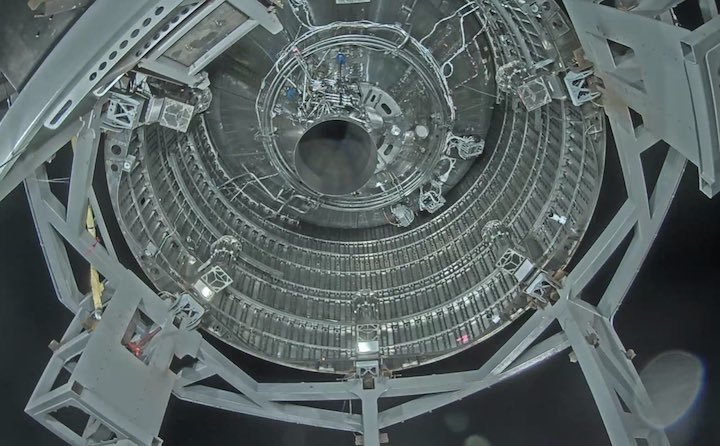
The Starship will function as the upper stage on a towering launch vehicle standing nearly 400 feet tall (120 meters). The first stage on the huge launcher, named the Super Heavy, will be powered by more than 30 Raptor engines, according to SpaceX.
Combined with the reusable Super Heavy booster, an operational Starship could haul more than 100 metric tons, or 220,000 pounds, of cargo to low Earth orbit, SpaceX said.
“Starship has the capability to transport satellites, payloads, crew, and cargo to a variety of orbits and Earth, lunar, or Martian landing sites,” SpaceX wrote in a Starship user’s guide released last month.
The Starship prototype currently being tested at SpaceX’s South Texas launch site is designated SN4. Three previous Starship vehicles were destroyed during pressure tests at Boca Chica, but SpaceX quickly moved on to the next Starship prototype as part of the company’s fast-paced iterative development process.
The next Starship in line, named SN5, could attempt a higher-altitude flight after SpaceX is done with SN4 testing.
Quelle: SN
----
Update: 11.05.2020
.
Boca Chica Beach, highway to close for SpaceX testing
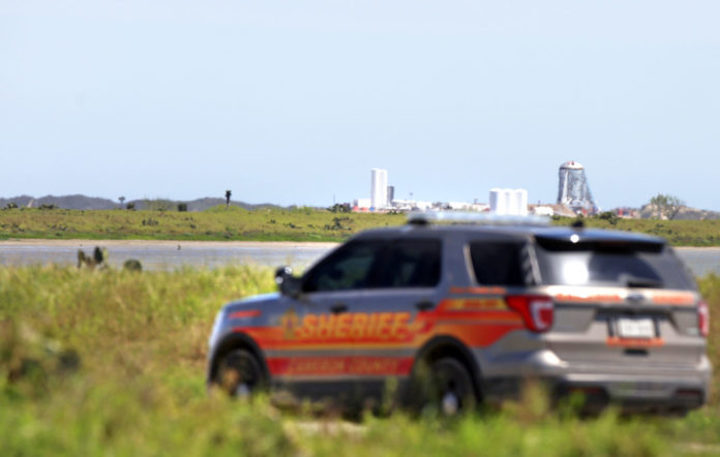
Highway 4 headed to Boca Chica Beach will be temporarily closed on Monday, May 11 for SpaceX testing of its newest rocket.
Cameron County Judge Eddie Trevino Jr. ordered the closure of Boca Chica Beach, plus Highway 4 from FM 1417 (Oklahoma Avenue) to the entrance of the beach.
“I have ordered the closure of Boca Chica Beach and Highway 4 for the purpose of protecting public health and safety during SpaceX testing on May 11, 2020, in the time period between 9 a.m. and 9 p.m. of the same day, and in the alternative on May 12, 2020, and/or May 13, 2020, from 9 a.m. to 9 p.m. of the same day,” Trevino said in a news release. “Should SpaceX should not complete its test launch activities on May 11, 2020, then SpaceX may use an alternate to complete its test launch activities.”
The county judge said SpaceX will set up a safety zone perimeter that will include two temporary checkpoints on Highway 4. Anyone who lives in the area will be allowed to go through the soft checkpoint and gain access to their property during testing.
But he said no one will be allowed to go through the hard checkpoint to the beach during the closures. Trevino said anyone wanting to visit a beach can still access any of the county’s other beaches.
Quelle: The Herald
----
Update: 12.05.2020
.
SpaceX’s Starship rocket just took a big leap towards orbit with latest test success
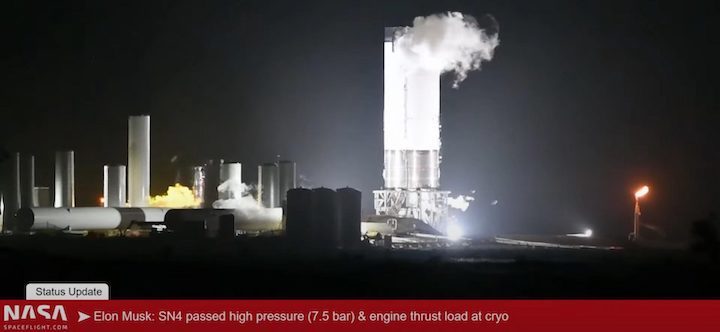
A full-scale Starship rocket has passed a critical test for the first time ever, strongly suggesting that the next-generation launch vehicle could be much closer to orbital readiness than most would imagine.
To be clear, a huge amount of work remains before Starship can be deemed anywhere close to its first orbital flight tests, not the least of which is the fabrication and assembly of the first massive Super Heavy booster(s). However, after Starship SN4’s latest successful May 9th test, it’s hard to see any apparent showstoppers that can’t be handled with a combination of fairly routine testing and iterative progress, as well as time and money. There is certainly room for improvement throughout the program but SpaceX has effectively demonstrated that the biggest practical concerns about its approach to Starship are moot.
Captured live on May 9th and 10th by local resident and photographer Mary (bocachicagal) with the help of NASASpaceflight.com, SpaceX worked for about two days to reconfigure its fourth full-scale Starship prototype after two successful Raptor engine static fires and prepare it for a different kind of test. That work mainly involved removing said Raptor and replacing it with a hydraulic ram stand used to simulate the thrust of 1-3 engines without actually needing to perform a static fire test, further allowing SpaceX to simulate much longer engine operations than its spartan test pad could survive. Around 9pm CDT on May 9th (02:00 UTC, May 10), Starship SN4’s latest trial began.
Known as a cryogenic pressure and load test, it differed from a prior “cryo proof test” completed on April 26th, in which Starship was fully loaded with liquid nitrogen (more than twice as cold as dry ice), pressurized to a bit less than 5 bar (~70 psi), and stressed with hydraulic rams. About a week later, after installing a Raptor engine on a full-scale Starship prototype for the first time ever, Starship SN4 fired up said engine on May 5th – another historic first for the next-generation launch vehicle. 30 hours later, SpaceX performed another wet dress rehearsal (WDR) with liquid methane and oxygen and fired up Starship’s Raptor engine again.
After about 48 hours of reconfiguration, SpaceX moved on to a much more serious cryogenic test. As noted by CEO Elon Musk, the 4.9 bar the rocket previously reached was accepted as enough to perform a Raptor static fire test and possibly enough for a low-stress, low-altitude flight test to ~150m (500 ft). For orbital flight, however, Starship needs to withstand a minimum of 6 bar (~90 psi), while 8.5 bar (125 psi) is preferable to give the rocket the 1.4x safety factor optimal for human spaceflight.
This time, SpaceX – having successfully gathered data from two static fire tests and several wet dress rehearsals – was ready to risk Starship SN4 and pressurized it all the way to 7.5 bar (~110 psi). While ~12% shy of minimum human spaceflight standards, Starship SN4 successfully reached and maintained 7.5 bar while the ship stressed with hydraulic rams to simulate the thrust of three Raptor engines, all of which it survived fully intact. What 7.5 bar does offer, however, is a 1.25x safety factor – on the higher end of aerospace industry standards for uncrewed orbital spaceflight (i.e. cargo/satellite launches).
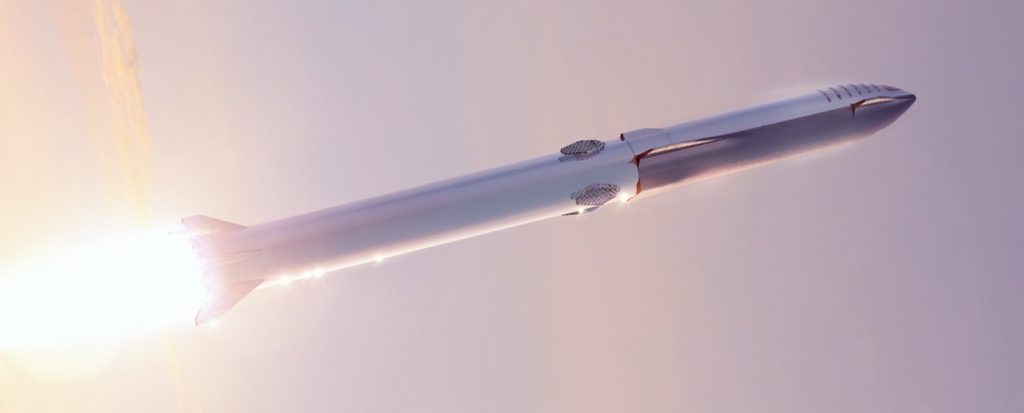
READY FOR ORBIT?
Technically, this means that – pending much additional testing and verification with different serial prototypes and (likely) higher pressures – Starship’s stainless steel structure is effectively qualified for uncrewed orbital launches. Of course, reality is much more complex. To actually perform and survive orbital flights, SpaceX will first need to build and similarly qualify the first Super Heavy boosters and ensure that those unprecedentedly large rockets can survive and sustain ~20-30 Raptor engines firing simultaneously.
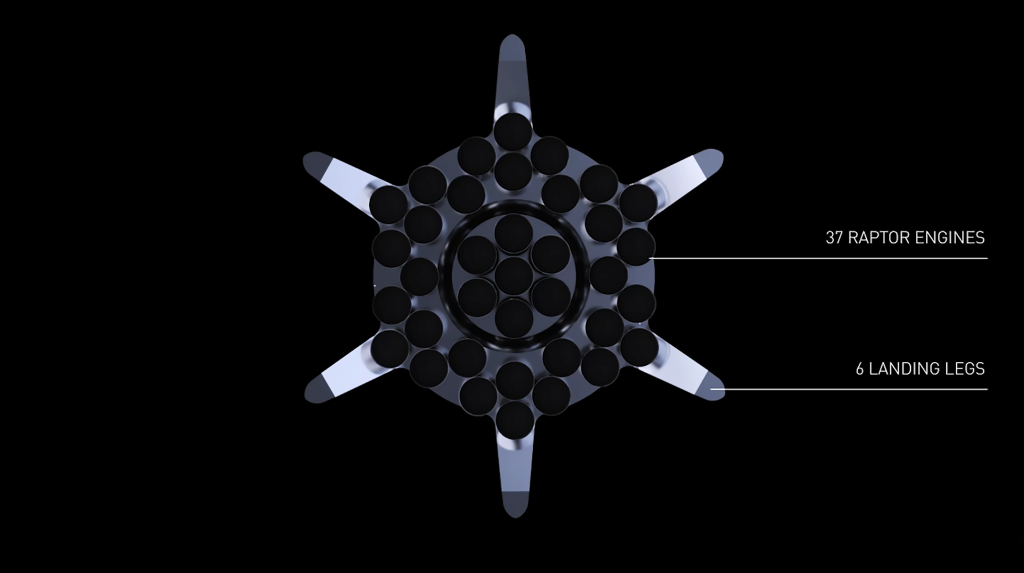
Aside from Super Heavy, it’s unknown if SpaceX has begun testing Raptor engines at the durations they will need to burn to booster Starships into orbit (TBD; likely 5-10 minutes of continuous operation). Along those lines, SpaceX also needs to build, test, and qualify Raptor’s vacuum-optimized sibling to complement the sea level version’s smaller, less-efficient nozzle. Still, Musk has already revealed that RaptorVac could be a matter of weeks from its first static fire and rocket engine development – while incredibly challenging – is more of a known quantity for SpaceX.
Perhaps the most important unknown is whether SpaceX’s recent May 2020 WDRs and static fires have used autogenous pressurization, a more efficient method of pressurizing rockets by using hot gas generated by their own engines. It’s extremely likely that SpaceX has been autogenously pressurizing Starship SN4 for its recent tests, but if that weren’t the case, it would be a big source of schedule uncertainty without significant redesign work.
Ultimately, SpaceX appears to have proven that orbital-class rockets can be built cheaply out of commodified steel in extraordinarily spartan production facilities. Many, many challenges remain but the biggest uncertainty and hurdle facing SpaceX’s Starship program and ambitions is well on its way to being fully put to rest.
Quelle: TESLARATI
----
Update: 14.05.2020
.
SpaceX’s first high-flying, triple-Raptor Starship is almost finished
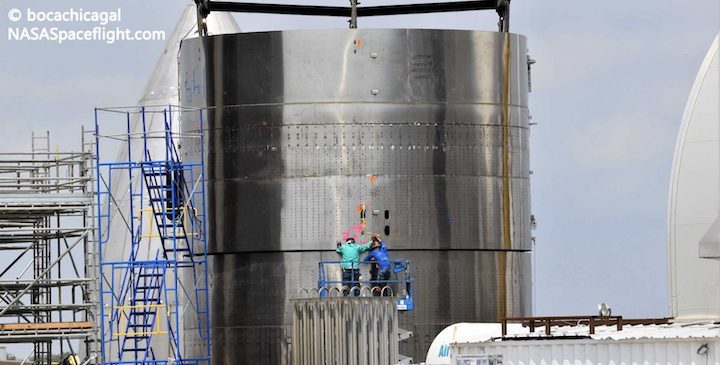
SpaceX’s first high-flying, triple-engine Starship prototype is rapidly approaching completion at the same time as the company is preparing for the rocket’s predecessor to lift off on its inaugural test flight.
Known as serial number 5 (SN5), it will be the fifth full-scale Starship prototype completed by SpaceX since November 2019 and the fourth since late-January 2020. Following in the footsteps of Mk1, SN1, SN3, and SN4, SpaceX CEO Elon Musk has recently stated that Starship SN5 will be the first prototype to have three Raptor engines and a nosecone installed and could be the first to be outfitted with new and improved aerodynamic control surfaces.
In the meantime, Starship SN4 is perhaps less than 30 hours away from performing a third Raptor static fire test, potentially paving the way for the biggest challenge yet for a full-scale Starship prototype: powered flight. Scheduled no earlier than 9am CDT (14:00 UTC), May 13th, Starship SN4’s next static fire is meant to ensure that a replacement Raptor engine is functioning properly. If successful, the building-sized rocket will effectively be ready to attempt its first launch – also a first for the Starship program overall – pending FAA approval.
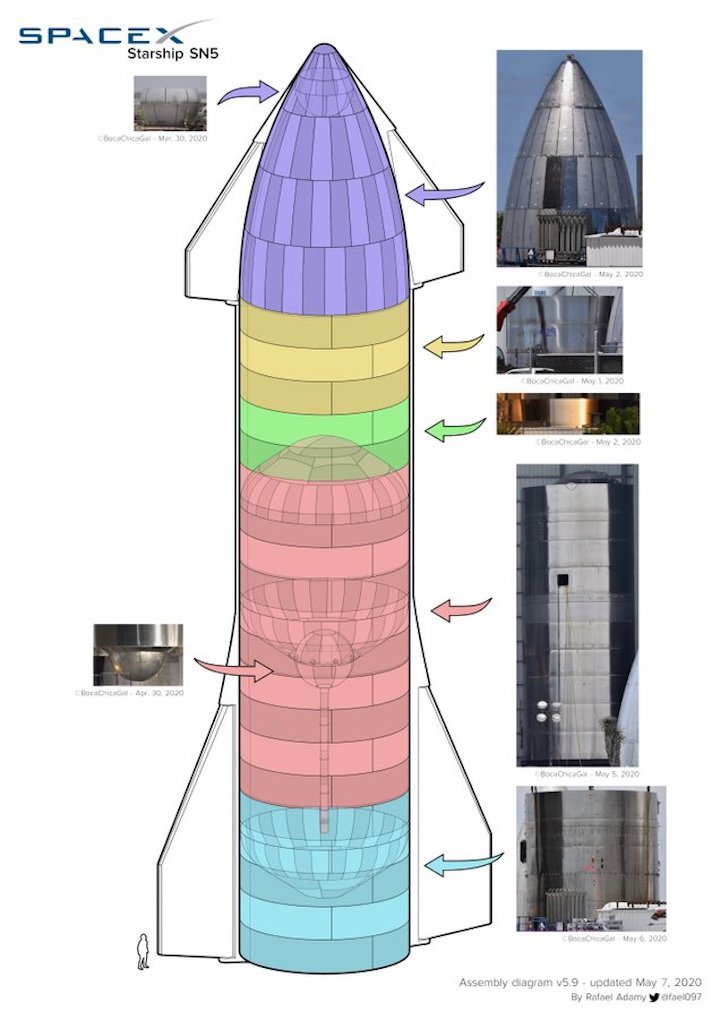
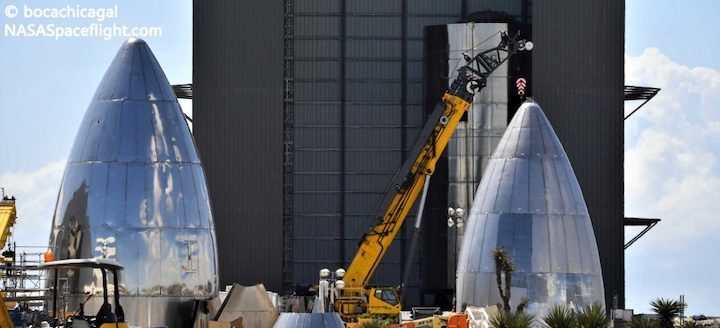
SpaceX’s fifth full-scale Starship rocket is likely just a matter of days away from partial completion. (NASASpaceflight – bocachicagal)
As illustrated in the unofficial diagram above, nearly all of the individual sections that will make up Starship SN5 appear to be more or less complete, excluding some ambiguity added by the interchangeable nature of some of the steel rings all Starships are built out of. For the current design and assembly strategy, Starships are comprised of eight separate sections, themselves made up of stacks of 2-4 steel rings. Altogether, excluding the conical nose section, a single Starship requires approximately 20 of those ~1.8m (6 ft) tall steel rings to reach its full height.
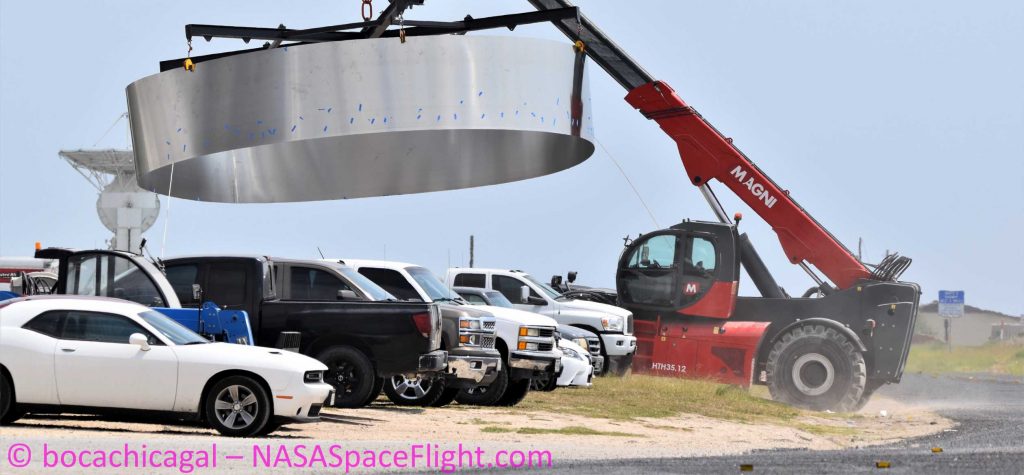
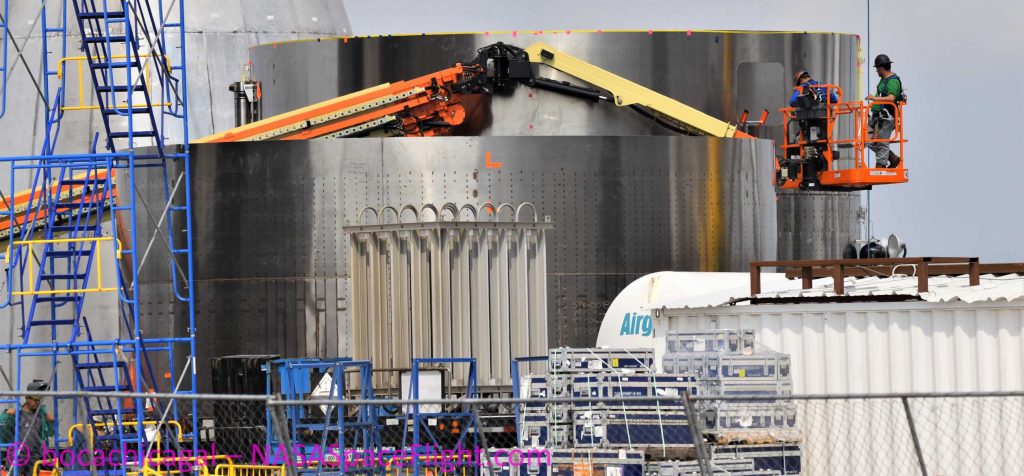
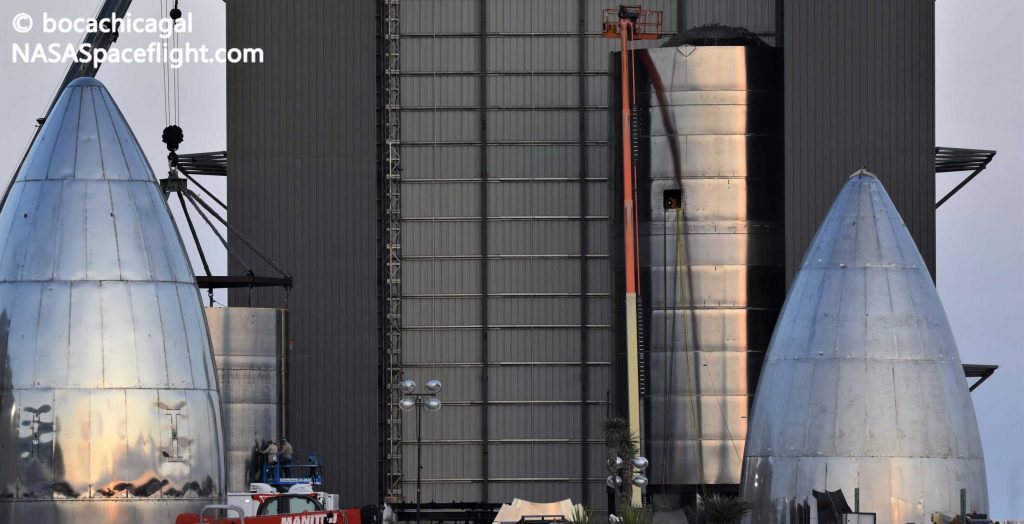
Currently, SpaceX has been focused on testing just the tank section of Starship prototypes, representing the vast majority of the technical challenges that must be solved to fully realize the next-generation launch vehicle’s ambitions. Excluding a smaller secondary liquid oxygen tank situated in the tip of Starship nosecones, the nose section is effectively irrelevant – putting the cart before the horse – until Starship tank sections are more of a known quantity.
When that would be the case was entirely up in the air until just the last week or so, when Starship SN4 became the first full-scale prototype to pass a cryogenic proof test, perform a wet dress rehearsal (WDR) with real propellant, complete static fire(s) with a Raptor engine installed, and – finally – pass a more challenging cryogenic pressure test in quick succession. With those milestones passed for the first time ever, SpaceX has effectively proven that it’s solved the what is arguably the most unprecedented aspect of its Starship program: building orbital-class pressure vessels for pennies on the dollar on the South Texas coast.
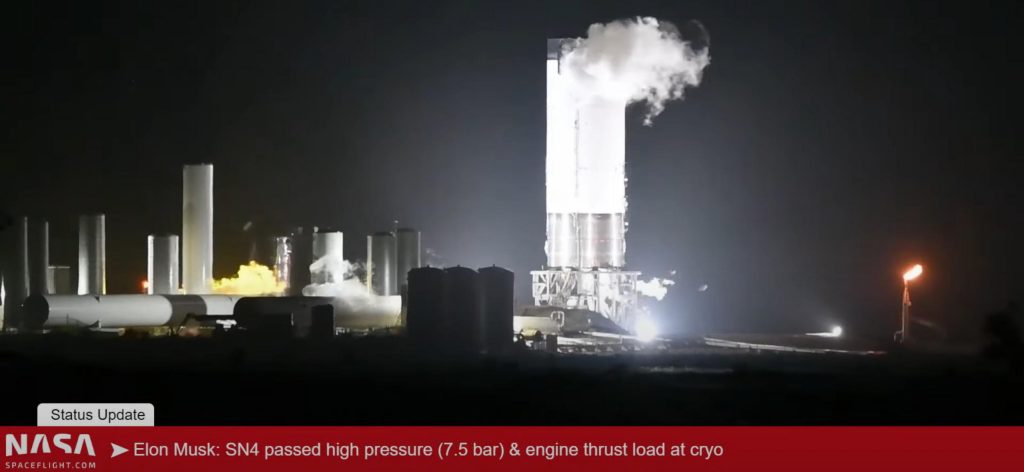
Of course, doing it once with Starship SN4 is not the same as fully confirming that SpaceX’s extremely exotic South Texas rocket factory is capable of producing repeatable results with future rockets. While incredibly improbable, Starship SN4’s multiple successes could be a fluke. Additionally, as Musk has noted, the goal is to complete two entire Starships every week once the factory is fully optimized. SpaceX has already achieved a monthly production rate for its current line of prototypes, an extremely encouraging sign for the practicality of Musk’s stretch goal.
In the prototype stage, that speed of production has been incredibly useful, enabling SpaceX to move at a pace of launch vehicle development almost unheard of since NASA’s Apollo Program. At the moment, Starship SN4 has passed all tests thrown at it so far and will soon be attempting the riskiest Starship test yet with its inaugural hop attempt. If the ship were to be destroyed, one would traditionally expect a bare minimum of a few months of program delay. Instead, Starship SN5 could be more or less complete even before SN4 receives FAA permission for its first flight, meaning that a replacement will already be ready to roll to the launch pad if or when SN4 is destroyed.
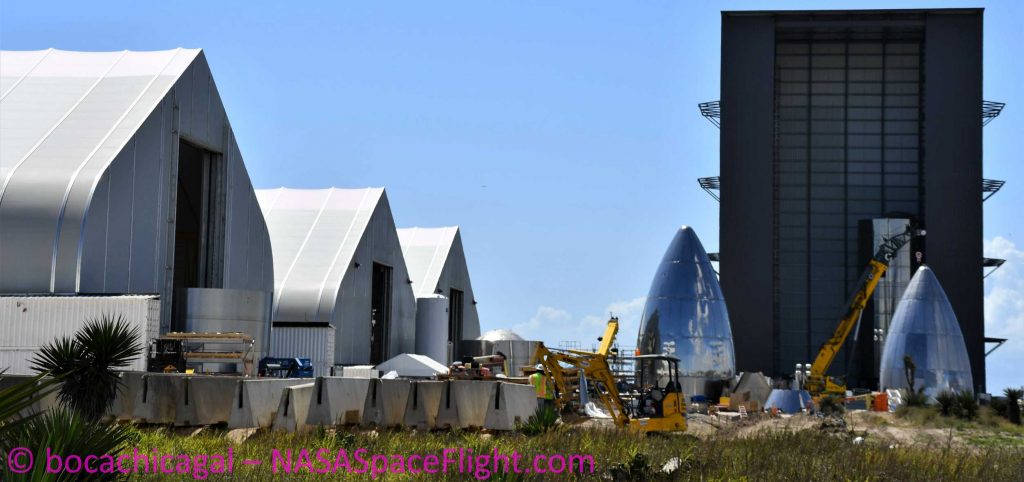
In a best-case scenario, if Starship SN4 continues to pass the tests thrown at it, including one or several hops, SpaceX will instead be entering a new phase indicative of what’s to come: the concurrent testing and operation of a fleet of Starships. A step further, if Starship SN4 succeeds, Starship SN5 appears to be on track to become the first prototype to have a full three Raptor engines and a nosecone installed, as well as the first to attempt a high-altitude (20 km/12 mi) flight test.
Quelle: TESLARATI
----
Update: 21.05.2020
.
SpaceX Starship prototype in limbo after engine test lights rocket on fire
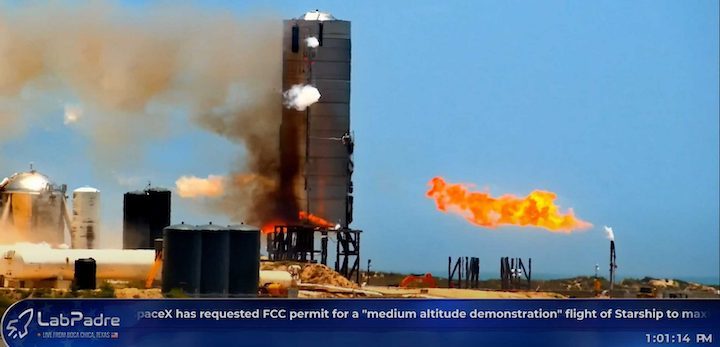
The fate of SpaceX’s fourth full-scale Starship prototype appears to be in limbo after a third (seemingly successful) engine ignition test unintentionally caught the rocket on fire.
Now more than 12 hours after Starship SN4 fired up its new Raptor engine, the ~30m (~100 ft) tall, 9m (~30 ft) wide prototype is apparently trapped with one or both of its propellant tanks still partially filled with liquid (or gaseous) methane and/or oxygen. An initial road closure scheduled from noon to 6pm local quickly came and went and SpaceX and Cameron County Texas have since modified the paperwork, extending the closure a full 24 hours. In other words, SpaceX has reason to believe that Starship SN4 may continue to be unsafe (i.e. pressurized) as many as ~30 hours after it technically completed its third static fire test – extremely unusual, to say the least.
There’s only one obvious conclusion to draw. Whether it was something invisible to the public eye or damage related to the off-nominal fire that burned for some 15 minutes after Raptor shut down, SpaceX appears – to some extent – to have lost control of Starship SN4.
That would render Starship – potentially perfectly healthy and operational – almost entirely uncontrollable, while also potentially removing SpaceX’s access to telemetry. In other words, the company may currently have no idea how pressurized all or part of Starship SN4 is and may also have little to no control of some or all of the rocket. For that to be true, Starship SN4 would, however, have to have less than fully redundant control hardware. To perform hops, for example, the ship would need both wired and radio links capable of sending telemetry and receiving commands to remain both on the ground and after liftoff.
It’s possible that Starship SN4 has the necessary hardware installed but that it wasn’t activated for the static fire test (think “Starship will never leave the ground, why would we need to enable wireless controls?”). It’s also possible that the blown pipe and methane leak that appeared to cause the secondary fire damaged crucial propellant management hardware (valves, pumps, etc.) or was just a symptom of an even worse overpressure event that damaged or destroyed multiple such systems.
Given that safety is almost certainly the priority, chances are that some combination of fairly mild hardware failure and telemetry/control loss has left SpaceX with just enough uncertainty that it can’t risk sending technicians to the launch site to inspect the damage and reestablish control. As a result, the only option left is to quite literally sit and wait until it’s once again safe to approach the rocket. Thankfully, at this point, the risk of the mystery problem actually destroying Starship SN4 is very low. If, as it appears, only its methane tank is affected, leaving some unknown quantity of latent liquid methane trapped inside, it’s possible that waiting will actually solve the problem and safe the rocket.
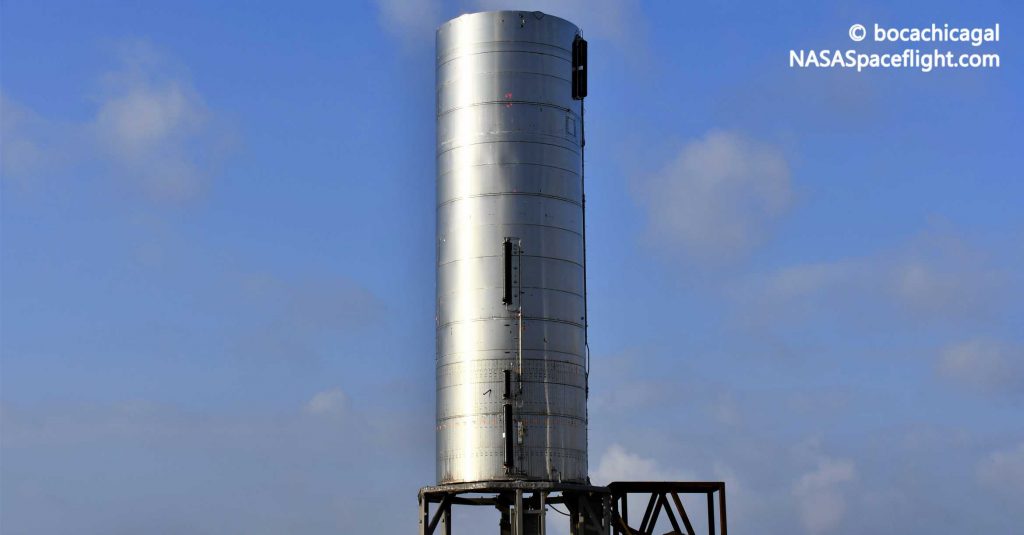
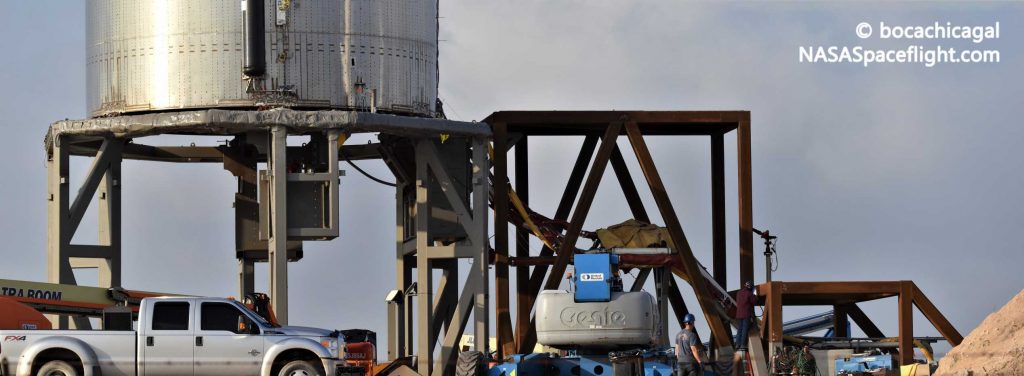
The fact that Starship hasn’t exploded yet strongly implies either that the amount of propellant trapped is minuscule or that the vast majority of SN4’s propellant management systems (including vents) remain functional. Assuming that’s the case, any remaining cryogenic propellant will eventually boil into gas, increasing the pressure inside Starship’s tanks, while those tanks will continue to vent to prevent an explosion or rupture. Eventually, Starship SN4 will be empty once again and SpaceX will be able to approach the rocket to regain control and begin inspections and repairs.
Regardless, after such an unintentionally eventful static fire test, it’s extremely unlikely that SN4 will be ready for its inaugural flight test within the next few days. Stay tuned for updates as SpaceX works to regain control over the fourth full-scale Starship prototype.
Quelle: TESLARATI
----
Update: 29.05.2020
.
MASSIVE EXPLOSION
